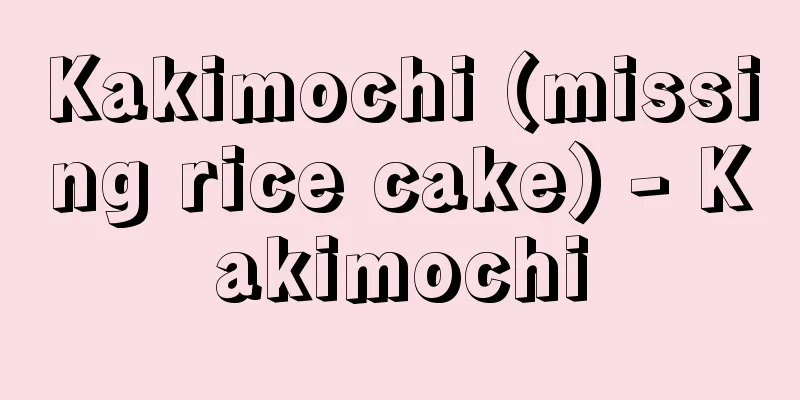Pillow words - pillow words

|
A modifying phrase used mainly in waka poetry. It is usually five syllables per phrase, has no direct semantic relationship with the main idea of the poem, and modifies only the modified word (pillow word). The way in which it is applied to the modified word is customary and fixed, and it is normal for a certain pillow word to be applied to a certain word, but it can also be extended to similar words. In ancient times, it was used not only in waka poetry but also in proverbs and oracles to apply to the names of gods, people, and places, which are thought to be the most primitive, and were originally words that praised the pillow word in a magical way. As it gradually lost its magical nature and its meaning became unclear, it was interpreted as having a secondary meaning and became a mere modifying phrase or a rhetorical device to adjust the tone. In the Manyo period, it was almost in the secondary meaning stage, and after the Heian period it became more and more formulaic and the number of types decreased. There are three types of classification: (1) based on the connection between the pillow word and the covered pillow word, (2) based on the nature of the covered pillow word, and (3) based on the nature of the pillow word, with (1) being the most common. (1) is further divided into (1) those related to meaning, such as adjectives, metaphors, and explanations, such as "ashi ga shiru Naniwa" (reeds scatter in Naniwa), "okinawa tsu tori kamo" (ducks), and (2) those related to sound, such as hanging words and homophonic repetitions, such as "tamakushige Futakamiyama" (mountain of a tiger), and "chichinomi no ochi" (father of a child). (2) is a classification that emphasizes the modifying function and era of the pillow word, dividing covered pillow words into (1) proper nouns, such as "soramitsu Yamato" (soramitsu Yamato), (2) common nouns, such as "ashihiki no yama" (mountain of an ash), and (3) verbs, such as "saku hana no utsurou" (flowers bloom in the dark). (3) is a classification based on the nature of the material of the pillow words. While relating (1) to (3) to each other, their origins and essences are considered. [Tatsuo Hashimoto] "Research and interpretation of pillow words" by Kyuzo Fukui (1927, Fuji Shobo, reprinted 1960, Yuseido Publishing) " "Ancient folk songs" by Hiroshi Dobashi (1960, Sanichi Shobo) [Supplementary material] |Source: Shogakukan Encyclopedia Nipponica About Encyclopedia Nipponica Information | Legend |
|
主として和歌に用いられる修飾句。通常は一句五音で、一首の主想表現と直接の意味的関連がなく、被修飾語(被枕詞)だけを修飾する。被修飾語へのかかり方は慣習的、固定的で、一定の枕詞が一定の語にかかるのを普通とするが、類似の語に拡大してかかる場合もある。古くは和歌に限らず、諺(ことわざ)や神託などにおいて、神名、人名、地名にかかる例があり、それがもっとも原初的なものと思われ、本来被枕詞を呪的(じゅてき)にほめたたえる詞であったらしい。それが徐々に呪性を失い、意味もわからなくなってゆくにつれて、二義的に解釈され単なる修飾句や声調を整えるための修辞となったのであろう。万葉時代はほぼ二義的段階のもので、平安時代以後はいちだんと形式化してゆき、種類も少なくなる。 その分類は、(1)枕詞と被枕詞との接続関係によるもの、(2)被枕詞の性質によるもの、(3)枕詞の性質によるもの、とする3種が考えられているが、(1)が一般的である。(1)はさらに〔1〕形容、比喩(ひゆ)、説明など意義に関するもの―「葦(あし)が散る 難波(なにわ)」「沖つ鳥 鴨(かも)」など、〔2〕懸詞、同音反復など、音に関するもの―「玉櫛笥(たまくしげ) 二上山(ふたかみやま)」「ちちのみの 父」などに分ける。(2)は被枕詞を、〔1〕固有名詞―「そらみつ 大和(やまと)」、〔2〕普通名詞―「あしひきの 山」、〔3〕用言―「咲く花の うつろふ」、などに分けてみて、枕詞の修飾機能や時代を重視する分類である。(3)は枕詞の素材がいかなる性質のものかによる分類である。(1)~(3)を相互に関連させつつ、その起源、本質などが考えられている。 [橋本達雄] 『福井久蔵著『枕詞の研究と釈義』(1927・不二書房/再版1960・有精堂出版)』▽『土橋寛著『古代歌謡論』(1960・三一書房)』 [補完資料] |出典 小学館 日本大百科全書(ニッポニカ)日本大百科全書(ニッポニカ)について 情報 | 凡例 |
<<: Makurazaki [city] - Makurazaki
>>: Pillow return - makuragaeshi
Recommend
Gambier Islands (English spelling)
Located in the southeastern end of the Tuamotu Arc...
Ezo purple azalea - Ezo purple azalea
A semi-evergreen shrub in the Ericaceae family (A...
Bakumatsu Taiyoden - Bakumatsu Taiyoden
A Nikkatsu film produced in 1957. This is the mast...
Xu Wei - Joy
A Chinese literary figure who excelled in poetry,...
Moritz Schlick
German philosopher. Born in Berlin. He obtained h...
Appeal - Jokoku
In procedural law, an appeal is made to a court o...
Shinadama
〘Noun〙① Acrobatic tricks performed in Sarugaku and...
Azure-winged magpie
A passerine bird of the crow family (illustration)...
Kidder Award
…He served as president of the American Archaeolo...
Satyridae
…A general term for insects belonging to the fami...
Prime number theorem
If the number of prime numbers not exceeding a nat...
Clara (English name) Sophora angustifolia
A perennial plant of the legume family. It grows i...
closure
...In the history of parliamentary systems, confl...
Butadiene rubber
A type of general-purpose synthetic rubber. Its a...
Khmer Art - Khmer Art
Hindu and Buddhist art that spread in Cambodia fro...









